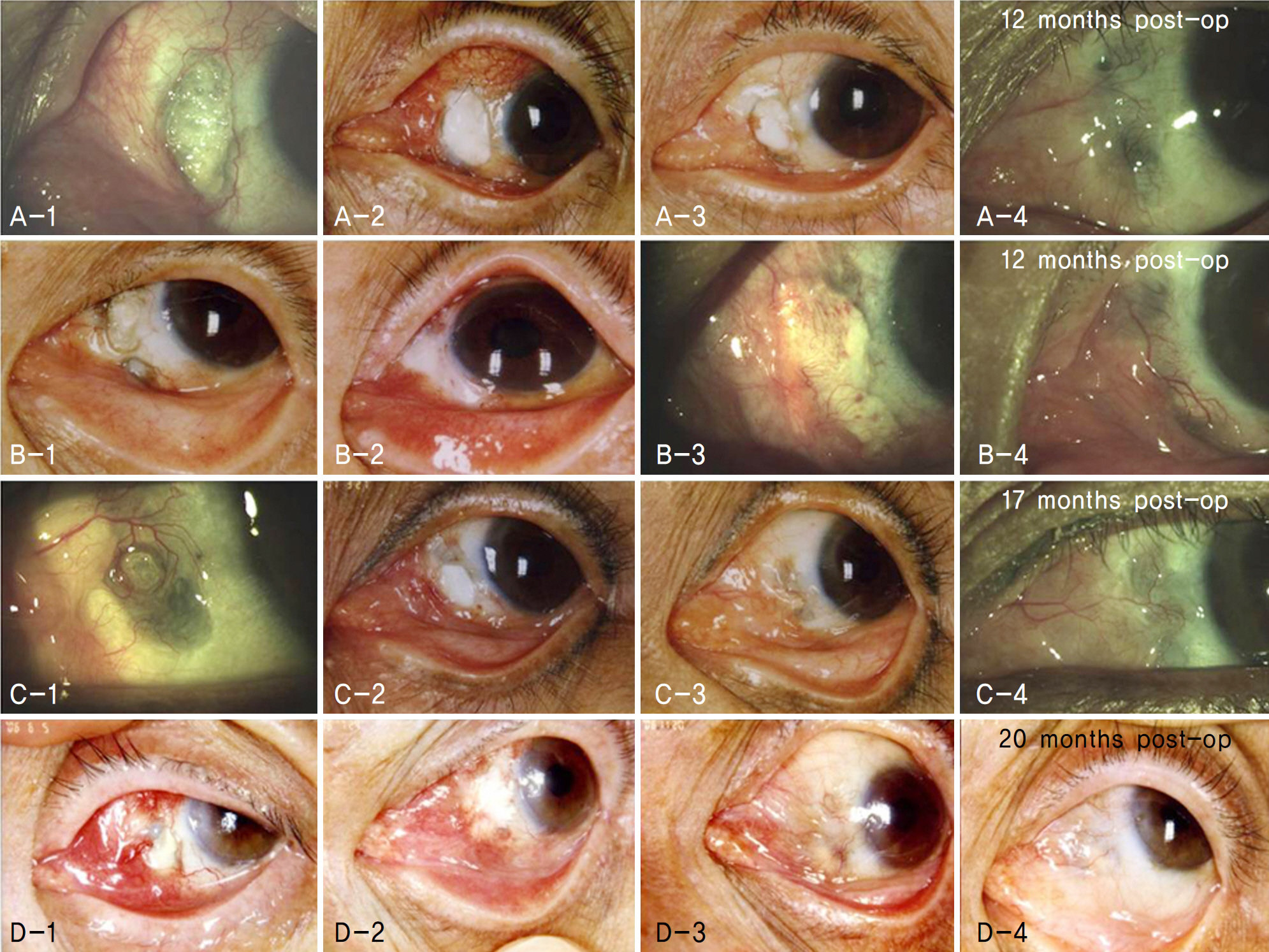J Korean Ophthalmol Soc.
2010 Apr;51(4):485-491. 10.3341/jkos.2010.51.4.485.
Scleral Allografting and Amniotic Membrane Transplantation With Fibrin Glue in the Management of Scleromalacia
- Affiliations
-
- 1Cheil Eye Hospital, Daegu, Korea. eyepark9@dreamwiz.com
- KMID: 2213378
- DOI: http://doi.org/10.3341/jkos.2010.51.4.485
Abstract
- PURPOSE
To examine the effects, complications, and safeties of sclera allograft and amniotic membrane transplantation with fibrin glue as surgical treatment methods for scleromalacia.
METHODS
The study included 14 eyes of 14 scleromalacia patients who needed surgical treatment. Among them, seven eyes of seven patients whose scleral defect was small (<6 mm) were operated on using only fibrin glue and no suturing, while seven eyes of seven patients whose defect was large (>6 mm) were operated on using fibrin glue and minimum suturing. Amniotic membrane transplantation was performed at the site of the conjunctival defect.
RESULTS
In all of the cases, the results of grafting were successful throughout the follow-up period, which was 14.6+/-4.4 months, on average (ranging from 12 to 27 months). No particular complication was observed during the follow-up period after using fibrin glue.
CONCLUSIONS
For scleromalacia patients, sclera allograft and amniotic membrane transplantation were performed using fibrin glue. The grafted sclera survived successfully, allowing this treatment modality to be considered an effective and safe option without complications.
Keyword
MeSH Terms
Figure
Cited by 1 articles
-
Scleral Graft, Free Conjunctival Autograft Using Tissue Adhesive and Temporary Amniotic Membrane Transplantation in Scleromalacia
Won Suk Choi, Gwang Ja Lee, Young Jeung Park, Kyoo Won Lee
J Korean Ophthalmol Soc. 2011;52(12):1405-1413. doi: 10.3341/jkos.2011.52.12.1405.
Reference
-
References
1. Hong SB, Oh SJ, Oh JH. The effects and complications of Mitomycin-C for prevention of recurrence after pterygium operation. J Korean Ophthalmol Soc. 1998; 39:2013–8.2. Moriarty AP, Crawford GJ, Mcallister IL, Constable IJ. Severe corneosclera infection: a complication of beta irradiation sclera necrosis following pterygium excision. Arch Ophthalmol. 1993; 111:947–51.3. Kwak JY, Chang HG. Autogenous temporalis fascia grafting and conjunctival flap transposition in scleromalacia after pterygium excision. J Korean Ophthalmol Soc. 2004; 45:180–6.4. Kim JH, Lee HB, Yoon DK. Scleral grafts for the cases of scleral perforation, scleral ectasia and scleral necrosis. J Korean Ophthalmol Soc. 1978; 19:55–64.5. Kim JH. Scleral grafting on necrotic scleritis following pterygium excision. J Korean Ophthalmol Soc. 1982; 23:29–39.6. Rhee HS, Kim MS, Kim JH. Scleral graft on necrotic scleritis abdominal pterygium excision. J Korean Ophthalmol Soc. 1987; 28:565–9.7. Lin CP, Tsai MC, Wu YH, Shih MH. Repair of a giant scleral abdominal with preserved sclera and tissue adhesive. Ophthalmic Surg Lasers. 1996; 27:995–9.8. Kim SY, Chung WS, Hahn DK. Surgical management of scleral necrosis. J Korean Ophthalmol Soc. 1995; 36:7–12.9. Oh JH, Kim JC. Repair of scleromalacia using preserved sclera graft with amniotic membrane transplantation. Cornea. 2003; 22:288–93.10. Na YS, Joo MJ, Kim JH. Results of sclera allografting on sclera abdominal following pterygium excision. J Korean Ophthalmol Soc. 2005; 46:402–9.11. Ozcan AA, Bilgic E, Yagmur M, Ersöz TR. Surgical management of scleral defects. Cornea. 2005; 24:308–11.
Article12. Sangwan VS, Jain V, Gupta P. Structural and functional outcome of scleral patch graft. Eye. 2007; 21:930–5.
Article13. Sohn YH, Yu SL, Uhm KB. Surgical treatment of sclera abdominal as a complication of pterygium excision. J Korean Ophthalmol Soc. 1995; 36:1323–30.14. Lee CO, Jong SH, Lee JJ. Autologous simple conjunctival graft and conjunctiva/tenon graft on focal scleromalacia. J Korean Ophthalmol Soc. 1997; 38:1737–41.15. Breslin CW, Katz JI, Kaufmann HE. Surgical management of abdominal scleritis: sclera reinforcement with autogenous periosteum. Arch Ophthalmol. 1977; 95:2038–40.16. Mauriello JA Jr, Fiore PM, Pokorny KS, Cinotti DJ. Use of split-thickness dermal graft in the surgical treatment of corneal and scleral defects. Am J Ophthalmol. 1998; 105:244–7.
Article17. Cohen RA, McDonald MB. Fixation of conjunctival autografts with an organic tissue adhesive. Arch Ophthalmol. 1993; 111:1167–8.
Article18. Koranyi G, Seregard S, Kopp ED. Cut and paste: a no suture, small incision approach to pterygium surgery. Br J Ophthalmol. 2004; 88:911–4.
Article19. Uy HS, Reyes JM, Flores JD, Lim-Bon-Siong R. Comparison of fibrin glue and sutures for attaching conjunctival autografts after pterygium excision. Ophthalmology. 2005; 112:667–71.
Article20. Yoon KC, Heo H, Jeong IY, Park YG. The use of fibrin glue for conjunctival autotransplantation in pterygium. J Korean Ophthalmol Soc. 2006; 47:198–204.21. Kajiwara K. Repair of a leaking bleb with fibrin glue. Am J Ophthalmol. 1990; 109:599–601.
Article22. Kaufman HE, Insler MS, Ibrahim-Elzembely HA, Kaufman SC. Human fibrin tissue adhesive for sutureless lamellar keratoplasty and sclera patch adhesion: a pilot study. Ophthalmology. 2003; 110:2168–72.23. Stenkula S, Gislason I, Törnquist R. Primary sclera atrophy and retinal detachment. Acta Ophthalmol (Copenh). 1981; 59:350–8.24. Mizano K, Hayasaka S. Penetrating keratoplasty with use of abdominal and sclera strip in acute corneal perforations. Ophthalmic Surg. 1982; 13:475–7.
- Full Text Links
- Actions
-
Cited
- CITED
-
- Close
- Share
- Similar articles
-
- Scleral Graft, Free Conjunctival Autograft Using Tissue Adhesive and Temporary Amniotic Membrane Transplantation in Scleromalacia
- Repair of scleromalacia with Preserved Scleral and Amniotic Membrane Transplantation
- Pterygium Surgery: Wide Excision with Amniotic Membrane Transplantation using Fibrin Glue
- Conjunctivochalasis Surgery: Amniotic Membrane Transplantation with Fibrin Glue
- Recurrence Rates of Amniotic Membrane Transplantation, Conjunctival Autograft and Conjunctivolimbal Autograft in Primary Pterygium



